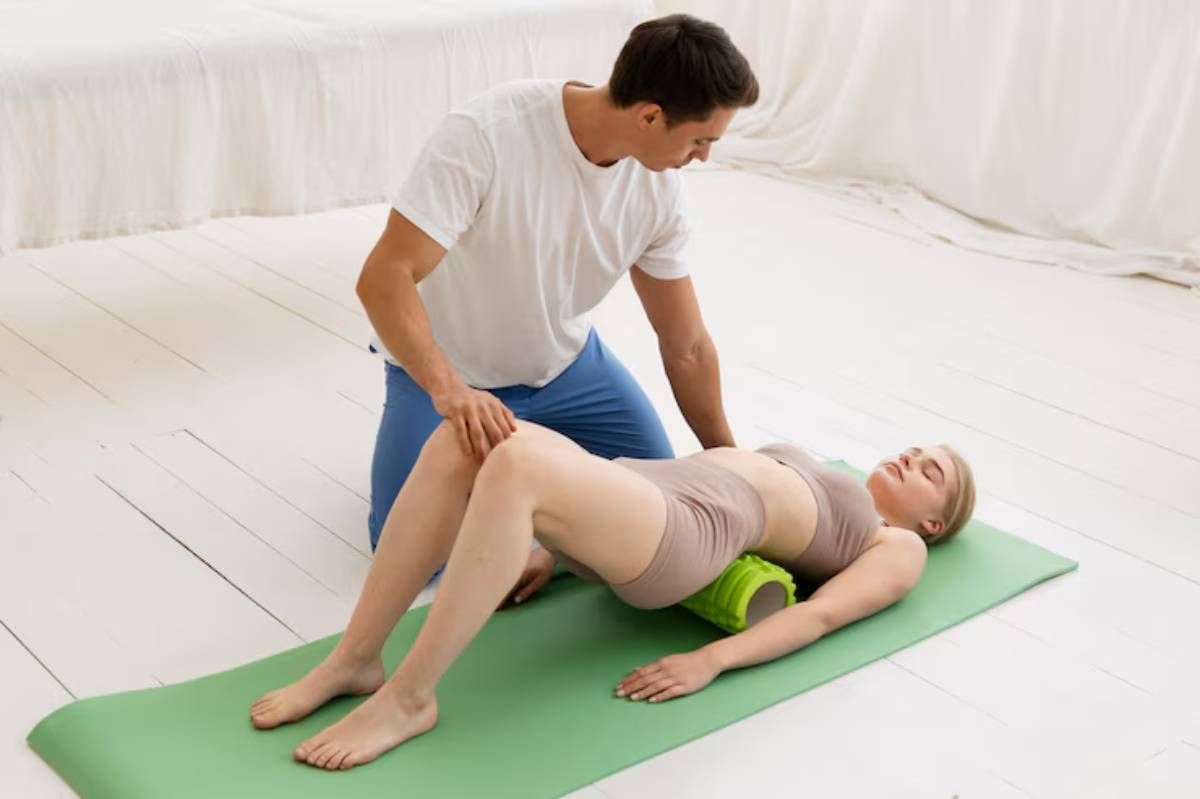
Best Times to Use Myofascial Release Techniques
You’ve probably heard how great foam rolling and self-massage tools are for reducing soreness and improving flexibility. But here’s the often overlooked question: When is the best time to use myofascial release techniques?
It turns out that timing matters just as much as technique. Whether you’re trying to unlock tight hips before a lift or unwind after a long day at your desk, knowing when to foam roll can dramatically affect its effectiveness. In this guide, we’ll explore ideal timings for post-training release, morning and evening sessions, and how to make daily recovery tips part of your routine.
If you’ve ever wondered whether to roll before or after your workout, on rest days, or in the middle of a stressful afternoon, this article will help you build a practical, personalised plan.
What Is Myofascial Release and Why Does Timing Matter?
Myofascial release is the process of applying gentle, sustained pressure to your fascia — the connective tissue surrounding muscles — to improve mobility, reduce stiffness, and ease muscle knots (trigger points).
Foam rollers, massage balls, and even your own hands can all be used to target these areas. The key is to relax the tissue, promote circulation, and encourage natural movement. But like any recovery method, results depend on when and how you use it.
Why does timing matter?
- Your fascia and muscles respond differently depending on your activity level and nervous system state
- Foam rolling before exercise can help with mobility and activation
- Foam rolling can promote recovery and relaxation
- Rolling at other strategic points in the day can reduce chronic tightness and aid posture
Let’s break it down.
Foam Rolling Before a Workout: Prepare, Don’t Punish
When to foam roll before training
Foam rolling before a workout is best used as part of your warm-up routine. The goal is to improve tissue quality and range of motion, not to deeply release or relax the muscle (which could actually reduce performance if done too aggressively).
Benefits of pre-workout myofascial release:
- Increases blood flow and muscle temperature
- Enhances mobility in key joints (hips, shoulders, ankles)
- Prepares tight areas for more efficient movement
- Improves neuromuscular readiness without fatigue
Areas to focus on:
- Hip flexors and quads (especially if you sit a lot)
- Lats and thoracic spine (for better shoulder function)
- Calves (for running and squat depth)
Keep it brief and moderate—no more than 30–60 seconds per muscle group. For best results, combine it with a dynamic warm-up routine.

Foam Rolling After a Workout: Recovery and Regeneration
When to foam roll after training
Post-training is arguably the most effective window for foam rolling. Your muscles are warm and pliable, which makes it easier to work through minor restrictions and encourage repair.
Benefits of post-training release:
- Flushes out metabolic waste (like lactic acid)
- Reduces delayed onset muscle soreness (DOMS)
- Helps muscles return to resting length
- Calms the nervous system post-exertion
Foam rolling immediately after strength or cardio sessions helps your body transition into recovery mode, especially if paired with deep breathing and stretching.
Areas to focus on:
- The muscles you trained (quads after leg day, back after deadlifts)
- Tight or overused areas, regardless of session type
- Areas that feel slightly inflamed or “pumped” (but not injured)
This is the time for slow, intentional pressure, holding tender spots for 20–30 seconds and breathing deeply.
Myofascial Release on Rest Days: Full Recovery Mode
You don’t have to be sore to benefit from foam rolling. In fact, your rest days are the perfect opportunity to give your fascia the attention it often misses during training days.
Benefits of rest-day foam rolling:
- Improves circulation without stressing the system
- Maintains mobility between sessions
- Prevents compensation patterns from building
- Supports nervous system regulation and better sleep
Think of it as low-effort maintenance — a form of active self-care that keeps your body moving well even when you’re not in the gym.
Make it part of a rest-focused recovery plan and pair it with walking, mobility flows, or stretching.
Morning Foam Rolling: Wake Up Your Body
Ever woken up with tight hips or a stiff lower back? Foam rolling in the morning can help ease into the day with better posture, mobility, and energy.
Best uses for morning rolling:
- Counteract stiffness from sleep
- Reduce chronic tension in common trouble areas (like traps or hips)
- Gently stimulate the nervous system without caffeine
- Create better posture and movement from the start of the day
Focus on gentle pressure, especially if your body feels cold or sensitive. Use a softer roller or a few gentle passes with a massage ball.
Evening Foam Rolling: Unwind and Destress
Evening foam rolling sessions are less about performance and more about relaxation. They’re a brilliant way to downregulate your nervous system and prepare for restful sleep.
Benefits of evening rolling:
- Releases the tension built up from daily stress and sitting
- Improves breathing and posture before bed
- Encourages the parasympathetic “rest and digest” state
- Enhances sleep quality and overnight muscle repair
Pair with light stretching or breathwork techniques for recovery and avoid stimulating areas like the IT band or lower back too aggressively.
Daily Recovery Tips for Smarter Foam Rolling
Here’s how to make the most of your foam rolling sessions, regardless of the time of day:
1. Keep sessions short and focused
Aim for 10–15 minutes max, focusing on one or two key areas. Rolling every muscle every day is unnecessary and counterproductive.

2. Breathe with purpose
Slow breathing helps your nervous system relax. Try a 4-second inhale, 6-second exhale rhythm.
3. Stay consistent
A few minutes a day beats one long session a week. Regular rolling keeps fascia hydrated, mobile, and responsive.
4. Use the right tool for the job
- Soft rollers for sensitive areas
- Firm rollers for big muscle groups
- Massage balls for pinpoint trigger points
- Peanut rollers for the spine and neck
5. Avoid rolling on injuries
If you’re bruised, inflamed, or healing from injury, skip that area and speak to a physio before rolling.
Weekly Foam Rolling Schedule Example
Here’s a basic foam rolling routine based on a typical training week:
| Day | Focus Area | When to Roll | Tool Used |
| Monday | Quads & calves | After leg day | Foam roller |
| Tuesday | Lats & pecs | Morning session | Massage ball |
| Wednesday | Hips & glutes | Rest day evening | Soft roller |
| Thursday | Hamstrings | Before workout | Firm roller |
| Friday | Traps & neck | After upper body | Peanut roller |
| Saturday | Full body sweep | Morning or night | Mixed tools |
| Sunday | Rest | Optional release | Soft roller |
Tailor the schedule to your own training, stress levels, and lifestyle. Your body’s feedback matters more than any protocol.
When Not to Foam Roll
Foam rolling isn’t always appropriate. Skip it or modify your technique if:
- You have acute or sharp pain
- You’re bruised or swollen in the area
- You’re recovering from surgery or a recent injury
- You have circulatory or bone conditions (check with a doctor)
Use foam rolling as a recovery aid, not a cure-all. If you’re unsure whether to roll, rest, or rehab, always err on the side of caution.
Conclusion: Timing Makes All the Difference
Foam rolling is more than just pressing on muscles with a hard tube. When done at the right time — whether it’s before a workout, after training, or during a quiet evening wind-down — it becomes a strategic tool for recovery, mobility, and long-term performance.
The best time to foam roll isn’t one-size-fits-all. It’s about aligning your goals (mobility, pain relief, nervous system reset) with your schedule and your body’s cues. With a bit of experimentation, you’ll find the rhythm that works best for you.
So whether you’re starting the day, finishing a tough session, or just trying to sit a little taller at your desk, take a few minutes to roll it out. Your muscles will thank you.


